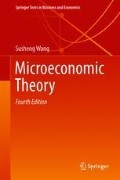Abstract
The previous chapter focuses on competitive markets under incomplete information. This chapter focuses on monopoly pricing under incomplete information. The basic modelling approach to monopoly pricing under incomplete information is the revelation principle, by which the uninformed strategically provide incentives for the informed to reveal their types.
Access this chapter
Tax calculation will be finalised at checkout
Purchases are for personal use only
Notes
- 1.
It generally pays for the company to separate the two types and exploit the differences. Hence, we generally expect a separating solution with a monopoly.
- 2.
The presence of IR conditions must be consistent with the calculation of the objective function. A different set of IR conditions implies a different objective function. For example, if one IR condition ensured that type H would not participate, then our objective function would not include the profits from type H.
- 3.
We can actually allow an agent’s utility function to take the form \( u_{i} \left( {x,\theta } \right) \) rather than \( u_{i} \left( {x,\theta_{i} } \right). \) All the concepts on Bayesian implementation are readily extendable to this case.
- 4.
Here we need \( s_{i}^{*} \left( \cdot \right) \) to be an onto mapping.
- 5.
This depends crucially on the nature of Nash equilibrium. In a Nash equilibrium, you assume that others will play the right strategies whatever you do; hence, if you cheat, you cheat on yourself only.
- 6.
We can define a social welfare function as the sum of the individual’s utility functions. This \( \delta \left( \theta \right) \) maximizes this social welfare function ex post, implying Pareto efficiency for each \( \theta \).
- 7.
If agents’ reports are not publicly observable, agent 1 needs to take expectations over \( \theta_{ - 1} \).
- 8.
This is the auction model, in which there are many competitive buyers, a single seller and a single indivisible item for sale. This model is popular in the literature of asymmetric information since it is the simplest case of monopoly pricing under asymmetric information.
- 9.
For each \( \theta \in\Theta , \) it is Pareto optimal since it maximizes social welfare \( SW \equiv R + \sum\nolimits_{i} {u_{i} \left( {x,\theta_{i} } \right)} . \)
- 10.
This BNE turns out to be the unique symmetric BNE when valuations \( \left\{ {\theta_{i} } \right\} \) are drawn independently from uniform distributions (Gibbons 1992, p.157).
- 11.
The proof of this proposition is in the problem set.
- 12.
For example, the case with \( \bar{\theta }_{1} < \underline{\theta }_{2} , \) in which it is certain that a trade can benefit both, is ruled out.
- 13.
For simplicity, I have narrowed down the monopolist’s admissible package offers.
- 14.
Here, \( \theta \) corresponds to \( c_{i} \) in Spence’s model and \( \theta_{i} = \varphi \left( {c_{i} } \right). \) A bad type has a big \( \theta \) and small productivity \( \varphi \left( \theta \right). \)
- 15.
Here, \( e^{ *} \left( \cdot \right) \) can be a strictly decreasing function, by which the company can recover the applicants’ types completely. However, this does not mean that the solution is the complete-information solution. This only means that the solution is a separating equilibrium. The complete-information is \( e^{ * *} \left( \cdot \right), \) which is generally more efficient.
- 16.
We may interpret the model as having many applicants who distribute alone \( \left[ {\underline{\theta }_{i} ,\bar{\theta }_{i} } \right] \) with population density function \( \phi \left( \theta \right). \) Hence, the objective function is the per capita profit.
- 17.
When two individuals have the same largest \( J_{i} \left( {\theta_{i} } \right), \) give the item arbitrarily to one of them. Furthermore, since \( J_{i} \left( \cdot \right) \) is increasing, \( \delta_{i}^{ *} \left( \theta \right) \) is increasing in \( \theta_{i} . \)
- 18.
This example is from Guesnerie and Laffont (1984). See also Laffont (1989, p.159).
- 19.
Laffont [1989, p.155, expression (7)] has this assumption. It means that the marginal utility \( v_{x} \) increases as \( \theta \) increases.
Author information
Authors and Affiliations
Corresponding author
Rights and permissions
Copyright information
© 2018 Springer Nature Singapore Pte Ltd.
About this chapter
Cite this chapter
Wang, S. (2018). Mechanism Design. In: Microeconomic Theory. Springer Texts in Business and Economics. Springer, Singapore. https://doi.org/10.1007/978-981-13-0041-7_11
Download citation
DOI: https://doi.org/10.1007/978-981-13-0041-7_11
Published:
Publisher Name: Springer, Singapore
Print ISBN: 978-981-13-0040-0
Online ISBN: 978-981-13-0041-7
eBook Packages: Economics and FinanceEconomics and Finance (R0)

